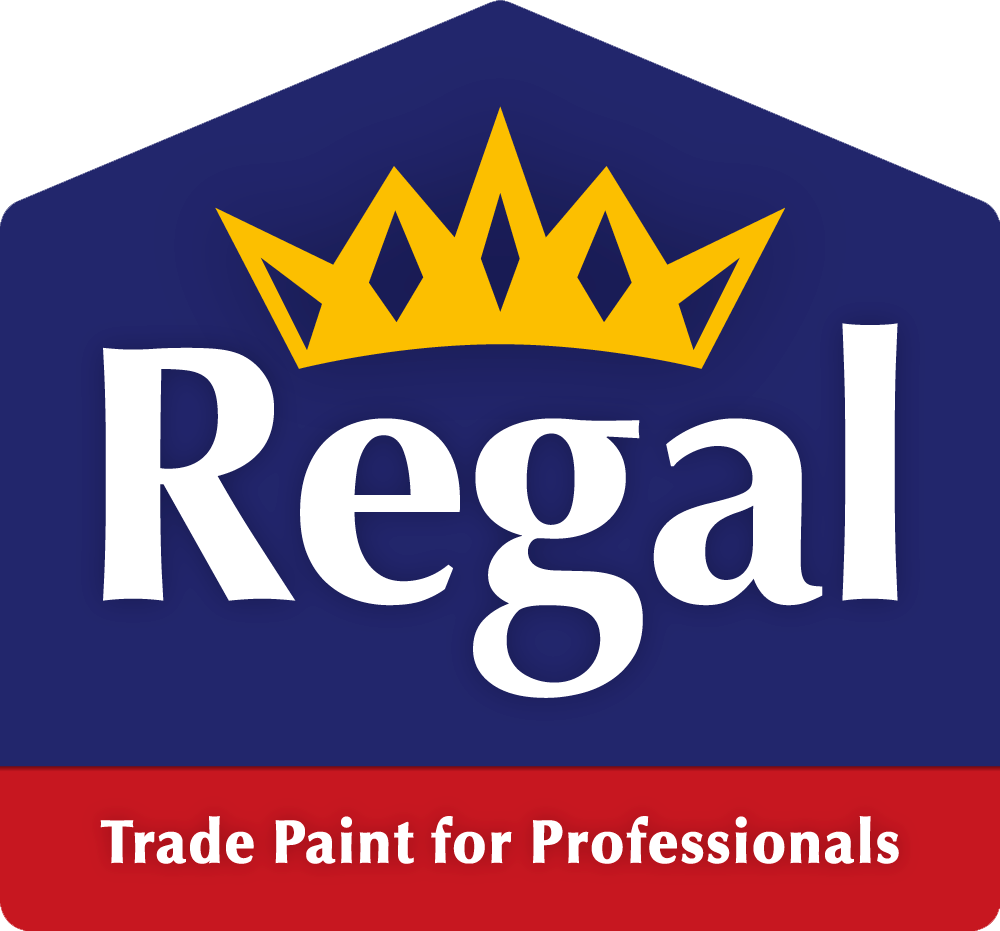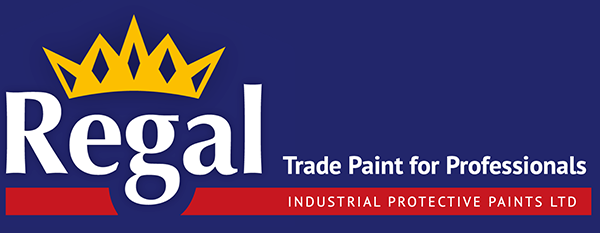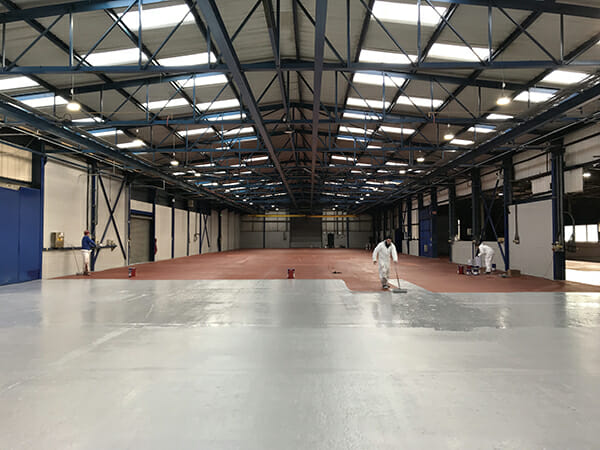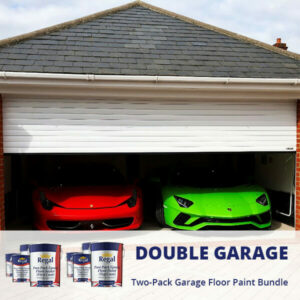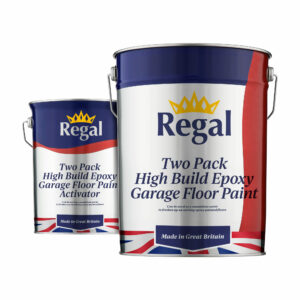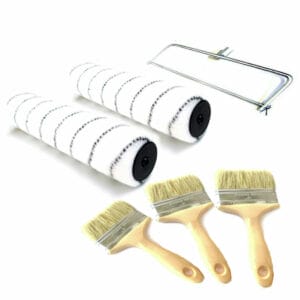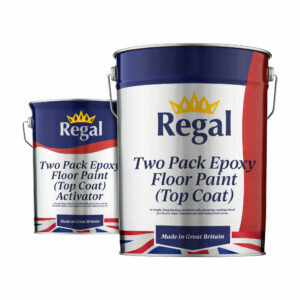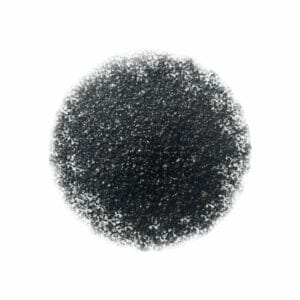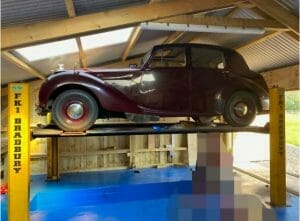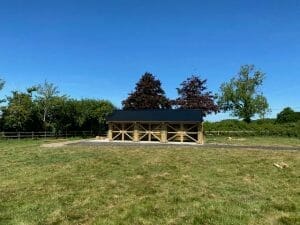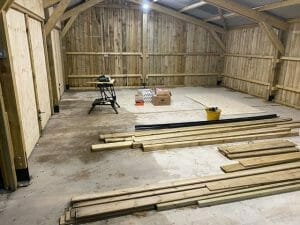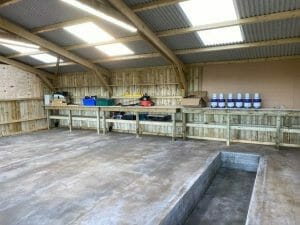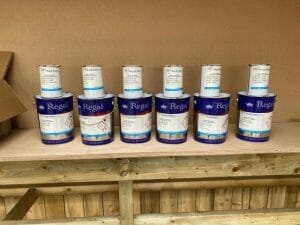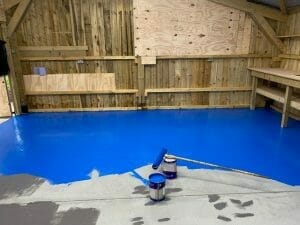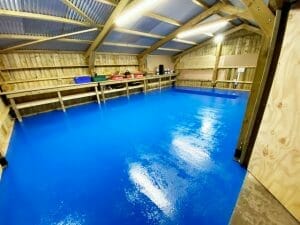Our Range of Floor Paint A-Z
Double Garage Two Pack Garage Floor Paint Bundle - This epoxy floor paint bundle is designed for application to concrete garage floors and provides enough paint to coat a standard double garage floor (see diagram for dimensions). This bundle consists of: 2 x 5 Lts Two pack Epoxy Floor Sealer 2 x 5 Lts Two Pack Epoxy Floor Paint Topcoat (Select Colour)
Our Double Garage Floor Paint Bundle is fast and effective way to paint a standard double garage floor (see diagram for dimensions). Simply prepare the concrete floor with Regal Prime and Seal and then coat to with a single pack quick dry floor coating in a colour of your choice! Our quick drying high build floor paint provides good durability against abrasion and impact along with with protection against solvent, salt and water damage. Our Double Garage Floor Paint Bundle consists of: 2 x 5 Lts Regal Prime and Seal 2 x 5 Lts Quick Dry High Build Floor Paint (Select Colour)
Single Garage Epoxy Floor Paint Bundle - This garage floor epoxy bundle has been designed for easy application to concrete garage floors and provides sufficient first coat and top coat epoxy paint to coat a standard single garage floor with a beautiful, hard-wearing finish (see diagram for dimensions). This bundle consists of: 1 x 5 Lts Two Pack Epoxy Sealer 1 x 5 Lts Two Pack Epoxy Floor Paint Topcoat (Select Colour)
Single Garage Floor Paint Bundle – This garage floor paint pack provides a quick and easy way to paint a standard single garage floor (see diagram for dimensions). Firstly, prepare the concrete floor with Regal Prime and Seal and then paint with a single pack quick dry high build floor paint for fantastic results. This top coat paint provides good durability against abrasion and impact along with with protection against solvent, salt and water damage. Our Single Garage Floor Paint Bundle consists of: 1 x 5 Lts Regal Prime and Seal 1 x 5 Lts Quick Dry High Build Floor Paint (Select Colour)
Anti Slip Quick Dry Concrete Floor Paint is a made with the addition of a wax additive to give more slip resistance to your floor. This is a single pack paint (does not need an activator) and gives protection against solvent, salt and water damage. Having good durability and impact resistance, it is suitable for use in heavy duty commercial and industrial areas. – Coverage: 5-10 m² per litre – Touch Drying Time: 3-6 hours – Recoat: 24 hours – Hard Drying Time: 48 hours
Two Pack High Build Epoxy Garage Floor Paint - Designed for application to concrete, cement and non ferrous metals. Excellent resistance to water, solvents, acids, alkalis and salts. Gives superb adhesion to all recommended substrates. Tough finish has long lasting abrasion and impact resistance. Recommended for areas receiving heavy traffic (vehicle / trucks). - Coverage: 5-7 m² per litre - Touch Drying Time: 12-16 hrs - Recoat: 24 hrs - Hard Drying Time: 48 hrs - Full Cure: 7 days
Line Marking Paint - A quick drying floor paint used to mark out safe zones, work areas, walkways, hazard areas etc on your floor. A durable coating with good resistance to abrasion and impact along with with protection against solvent, salt and water damage. Ideally suited to factory floors, warehouses, service garages, car parks and other industrial areas where long lasting and clearly visible markings are required. Available in five colours.
Painting Essentials Sundries Pack - ideal for applying both single pack garage floor paint and two-pack epoxy floor paint. 3 x 4" brushes 1 x 15" roller frame 2 x 15" roller heads
Polyurethane Concrete Floor Paint - A single pack high build floor coating giving medium durability against abrasion and impact, with limited protection against solvent, salt and water damage. Polyurethane Concrete Floor Paint is easy to apply with a gloss or semi-gloss finish. Suitable for light commercial and industrial areas.
This is a fast drying garage floor paint. A single pack, one-part paint which is easy to apply. Suitable for medium to heavy traffic areas, commercial and industrial use. Gives good protection against solvent, salt and water damage. UK made in our factory to give you one of the best garage floor paints. Available in a range of popular colours, grey garage floor paint being the bestselling colour. If you are looking to paint concrete which is bare or if you are repainting a concrete floor, we would recommend the use of Regal Prime and Seal which is our garage floor sealer, designed to coat the bare concrete or spot-prime worn areas.
Quick Dry High Build Floor Paint - A single pack quick dry floor coating which provides good durability against abrasion and impact along with with protection against solvent, salt and water damage. Very easy to apply. Suitable for heavy duty commercial and industrial areas.
Two Pack Epoxy Floor Paint (Top Coat) - This epoxy floor coating is designed for application to concrete, cement and non ferrous metals. It provides excellent resistance to water, solvents, acids, alkalis and salts and gives superb adhesion to all recommended substrates. Tough finish has long lasting abrasion and impact resistance. Recommended for areas receiving heavy traffic (vehicle/trucks). Following application of the product: Do not park vehicles or place heavy equipment on the floor for a minimum of 48 hours Do not get the floor wet for a minimum of 7 days as this will cause bloom (discolouration) - Coverage: 5-7 m² per litre - Touch Drying Time: 12-16 hrs - Recoat: 24 hrs - Hard Drying Time:48 hrs - Full Cure: 7 days
Two-Pack Epoxy Floor Sealer (Under Coat) - This epoxy floor paint (first coat) is designed to prepare the surface of concrete, cement and non ferrous metals. This gives an ideal base for epoxy topcoat or acts as a seal coat for bare concrete floors. Resistant to water, solvents, acids, alkalis and salts. Tough finish, and has long lasting abrasion and impact resistance. Recommended for areas receiving heavy traffic (vehicle/trucks). Following application of the product: Do not park vehicles or place heavy equipment on the floor for a minimum of 48 hours Do not get the floor wet for a minimum of 7 days as this will cause bloom (discolouration) - Coverage: 5-7 m² per litre - Touch Drying Time: 12-16 hrs - Recoat: 24 hrs - Hard Drying Time: 48 hrs - Full Cure: 7 days
Regal Clear Finish is ideal as a finishing coat over our epoxy or single pack floor paints to enhance gloss levels. A 2-pack acrylic which is fast drying and has excellent hardness. To be applied very thinly.
Floor Primer made to use in conjunction with any of the Regal single pack topcoat floor paints. Not suitable for use with our epoxy topcoat floor paint. Regal Prime and Seal is a single pack, quick drying, low viscosity, penetrating first-coat floor primer. Designed to soak into the substrate, it enhances adhesion of subsequent top coats by acting as an anchor layer between the substrate and floor paint. Regal Prime and Seal dries with a flat finish. The colour is non specific. - Coverage: 5-10 m² per litre - Touch Drying Time: 2-4 hours - Recoat: 24 hours - Hard Drying Time: 24 hours You might be thinking does floor paint need primer? Please read our information page 'what does floor primer do?'.
SuperTough Aggregate is an iron-silicate grit. With much larger particles than our Pumice Aggregate, it has a hard, sharp finish to give fantastic grip when used in conjunction with our floor paints. To use SuperTough Aggregate, firstly apply a coat of floor paint and then liberally scatter the grit over the surface of the wet paint. Allow the floor to dry for a full 24 hours. Once dry, use a soft brush to remove the excess SuperTough Aggregate that hasn’t stuck. Then paint over the whole surface of the floor again to seal the grit in place on the floor.
What Makes a Good Floor Paint?
Like any manufactured coating, the end product is only as good as the quality, quantities and combination of the raw materials that are used. As an established business, we have excellent trading relationships with our worldwide suppliers and we source and buy only high-quality resins, pigments and solvents. We do not pack our products with fillers. Over the last few years, the market has been flooded with cheaper products. We cannot comment on the quality of these paints, but if you want a coating which has been manufactured with care, using superior materials here in the UK, look no further than us.
Common Mistakes when Painting a Floor (and How to Avoid Them) FAQ
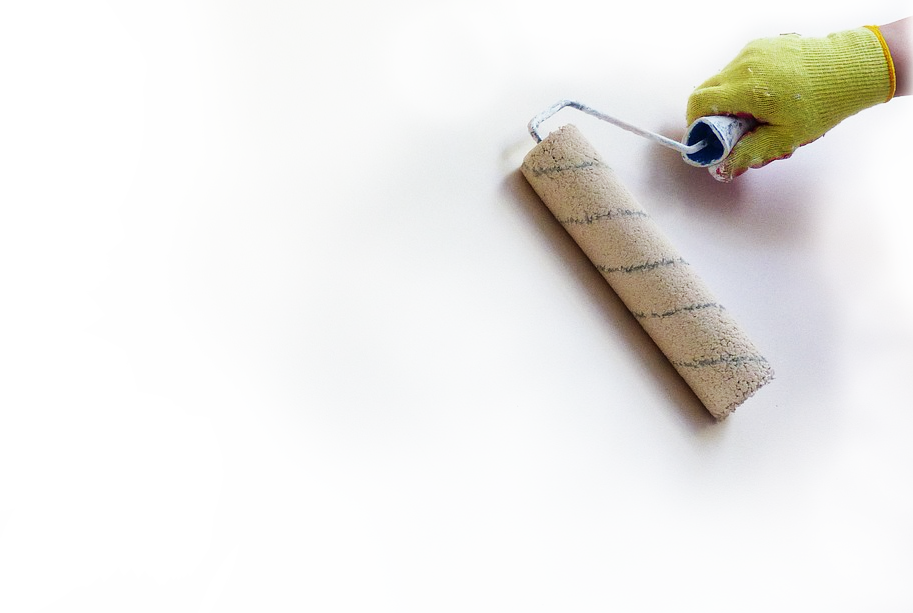
Painting new concrete that is not completely dry
So what happens if you paint concrete which is not completely dry? Even though you may think that the concrete is bone dry, there may still be moisture in the substrate which needs to evaporate. Should you mistakenly paint over still-damp concrete, you may find that the paint starts to delaminate. This happens because as the moisture rises during evaporation, it becomes trapped underneath the layer of paint. The moisture has no means of escape and so it literally pushes the paint from the surface. To avoid this, please always check the moisture level of your concrete. Please see our blog on how to do this.Painting a power-floated floor that is not properly prepared
A power-floated floor has a very smooth surface. It is the smoothness that prevents the floor sealer from penetrating and locking with or bonding with the surface. The floor sealer will merely sit on the surface of an unprepared power-floated floor. Then, after a topcoat floor paint is applied, no matter if you buy a cheap or expensive product, with time the sealer and topcoat will peel from the floor. This is known as delamination. Power-floated floors are expensive and, generally, people who have spent a lot of money on an amazing floor want an equally excellent finish from the paint. It is absolutely paramount that if you have a power-floated floor you properly prepare it by means of mechanical abrasion or chemical abrasion. The method chosen will depend on how smooth the surface is. Abrading the floor creates a certain level of roughness on the surface of the smooth concrete. These tiny undulations give the sealer coat something to key into and therefore increases the likelihood of a bond between substrate and coating, reducing the chance of delamination. We always recommend the use of a sealer coat on any bare concrete floor as the sealer acts as the glue between substrate and topcoat. For more information, please see our blog on painting a power-floated floor.Painting a poorly prepared floor
There are many phrases out there but to coin one: you can't make a silk purse out of a sow's ear. Similarly, you can't create a showroom-finish floor by buying some paint and just slapping it on the floor. It is imperative that you prepare the surface prior to painting. Moisture, dust, dirt and stains, poor quality concrete, air holes in the concrete, too smooth-a-finish etc can all cause issues with paint when it is applied. Similarly you can't use paint to smooth out a floor by putting it down thicker on bumpy parts of the floor - you will create pools of paint which will surface dry and stay soft underneath as the solvent becomes trapped under the cured top skin. If you are unsure about floor preparation, please have a look at our blogs or contact us and we are here to help.Painting an external floor
Our products are manufactured for commercial and industrial use, usually inside factories, garages etc. Our paints have not been tested for use on an external floor, however we do know that many of our customers use it for this purpose. We always try to explain that with any paints on an external floor, there is a risk that water, e.g. if it rains, may become trapped under the paint as it tries to evaporate and so may lift it. This is always a risk, however many customer are happy to try and have some great results.Applying the paint too thickly
Our paint is manufactured with a high opacity. This means that there is a good coverage and you don't get the 'see through' effect of some paints you may have bought elsewhere. You don't need to apply the paint thickly to give good coverage. Thickly applied floor paints are likely to take a lot longer to dry. This is especially true when the weather is hot; in hot weather, thickly applied paint will cure on the surface quite quickly as the solvent evaporates and the paint cures at an accelerated rate. However, what happens to the paint below the surface? The solvent which is trying to escape has nowhere to go as it has to battle its way through the hardened surface. So the paint will look dry, may feel dry to the touch, but will most probably still be 'soft'. If you were to dig your fingernail into it, there may be a mark left. If you were to drive on it, it may leave marks. If you are experiencing this problem, paint a thin amount of paint onto the lid of the can (if you still have it) and check to see if it dries properly. If you are unsure, please contact us and we are here to help.Re-coating before the paint is dry
This is a big no-no! Please always make sure that the sealer coat or first coat of paint is completely dry before overcoating. You shouldn't really need to do a second application of topcoat unless you haven't used a sealer. Irrespective of this, any overcoating of uncured paint may lead to problems such as solvent entrapment.Getting epoxy wet within 7 days
Getting epoxy paint wet without giving it at least 7 days to cure may lead to white patches appearing on the paint. This is known as amine blush or amine bloom. For more information, please see our blog post.Not using a primer coat
The use of a floor primer coat is always recommended to give you longevity of finish. The primer coat acts as a bond between the substrate and the topcoat. Sometimes people choose not to use a primer coat - this may be due to the cost involved or, for example, if you are moving premises and need to make the floor good before vacating. This is not a problem for a short-term solution. However, to make your floor coating last longer, we do recommend that a primer coat is always used over a bare surface.Mixing epoxy and then leaving it in the can for hours prior to use
The nature of epoxy is such that once the activator is mixed with the pigmented resin, the chemical curing process begins. Epoxy paint has a pot-life of approximately four hours so do not mix it until you are ready to use it. If you mix the two parts together and then leave it in the can for hours, it will 'go off' in the can. It will become a solid, unusable chunk of colour.Using a roller tray
Using a roller tray may create more problems than it solves. Our paints dry quickly; paint in a roller tray is likely to become crusty in parts, as the residual paint starts to dry. This may then peel from the plastic tray and become mixed in with the paint freshly poured into the tray, creating a bitty or lumpy mix. We recommend pouring the paint directly onto the substrate and then rolling out with a solvent-resistant sleeve. We have application instructions available for you to look at, but we are always at the end of a phone call or email if you would prefer to ask directly.Not mixing paint properly
The ingredients used to make paint vary in density. Similar to the cream rising to the top of the milk, the less dense particles in paint are likely to reside at the top of the can and the heavier particles towards the bottom. The paint will therefore need a good mix before using. If you do not mix paint properly prior to using, you might find some of the heavier pigments may remain at the base of the can. We recommend the use of a mechanical paint mixer which is attached to a drill. If you haven't mixed the paint prior to application, you may see streaks of pigment and/or may have curing problems.Not adding the activator to the epoxy resin
If you have done this, you are certainly not the first person to make this error. Please always read the technical information which is alongside each of our products online. If you have never used industrial floor paints, whether single pack or two pack epoxy, please contact us as we have a wealth of knowledge to share with you and to help you get the best for your floor from our products. If you forget to mix the two parts of the epoxy system together, and simply paint the pigmented resin onto the floor, it is not good news. Without the activator, the paint is incomplete - the chemical reaction which starts the curing process cannot happen and the pigmented resin will never dry. It will need to be scraped up off the floor. Two-pack epoxy is paint is like any other epoxy product, such as glues, which require two parts to be mixed together in order that they work as a whole.Regal Paint® - Floor Paint Manufacturers
Regal Paint® manufactures hard wearing, long lasting, high-performance floor paint for a complete range of applications, both industrial and commercial. Our floor paints are ideally suited for application on warehouse floors, factory floors, commercial garages, MOT centres, showrooms, chemical plants, galleries and much more. Regal Paints are specialist manufacturers of epoxy floor paint, concrete floor paint, quick-drying paint, garage floor paint and more. Please contact us to discuss your requirements or consult our floor coatings FAQ section for more information..